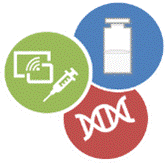Combination Products Training Courses
Combination Products Consulting Services LLC
Training Overview:
Combination products, i.e., those medical products comprised of more than one type of constituent part (e.g., “drug device combinations,” drug/device, biological product/device, drug/device/biological product) are of growing importance to the healthcare industry, particularly in light of the pronounced growth of biological products that are dependent upon medical devices for their safe and effective administration.
Combined use of different medical product types raises questions about potential interactions between the constituent parts, and potential impacts to safety, efficacy, usability, reliability, and performance. Regulators are recognizing the increased complexity associated with combination products, and as such, are implementing regulatory frameworks and applying increased scrutiny to combination products both pre- and post-market. This highly interactive training course delves into key aspects of combination product development and lifecycle management, and includes case studies throughout.
This comprehensive training course:
Principle Learning Objectives:
Key Topics:
Who Should Attend?:
Individuals accountable and/or responsible for R&D Project Management, Product & Process Development Scientists and Engineers, Regulatory Affairs, Quality, Clinical Affairs, Manufacturing, Post Marketing Safety Reporting
Pre-course Work Materials
Interactive Exercises
Learning Assessments
Certificate issued upon course completion.
Training Overview:
Combination products, i.e., those medical products comprised of more than one type of constituent part (e.g., “drug device combinations,” drug/device, biological product/device, drug/device/biological product) are of growing importance to the healthcare industry, particularly in light of the pronounced growth of biological products that are dependent upon medical devices for their safe and effective administration.
Combined use of different medical product types raises questions about potential interactions between the constituent parts, and potential impacts to safety, efficacy, usability, reliability, and performance. Regulators are recognizing the increased complexity associated with combination products, and as such, are implementing regulatory frameworks and applying increased scrutiny to combination products both pre- and post-market. This highly interactive training course delves into key aspects of combination product development and lifecycle management, and includes case studies throughout.
This comprehensive training course:
- can be customized to meet your needs (e.g., (1) executive leadership condensed training, (2) overview training for those that need familiarity but not deep expertise, (3) comprehensive training for those directly responsible for combination products day-to-day, and (4) in-depth training in specific subject matter. Course length and content will be adjusted to suit your needs.
- is offered virtually or in person. (On-line learning options are under development, and may be made available for use within your organization.) It can be delivered modularly to accommodate time zone differences.
- includes drug/ biological product-led (medicinal product) and device-led combination products. The class covers primarily US and EU approaches, while also touching on requirements for other jurisdictions.
Principle Learning Objectives:
- Clearly define and identify what constitutes a combination product
- Identify applicable regulations, guidance, and standards applicable
- Review and address challenges associated with the combination product lifecycle
- Ability to understand and apply the required combination product development elements
- Understand and apply integrated risk management,
- Integration of QbD and Design Controls, and application of Design Control elements
- Understand and apply Human factors, and use related risk analysis
- Identify key control strategy considerations
- Understand post market expectations and safety reporting
- Combination Product Inspection Readiness
Key Topics:
- What is a combination product?
- A global perspective.
- Product designation
- Borderline products
- Challenges:
- Language
- Integrated Processes
- Culture and Organization
- Supplier Collaboration
- Regulatory Frameworks, Challenges and Strategies:
- US FDA:
- 21 CFR Part 4 as a Foundation
- "Streamlined Approach"
- Low Risk Devices, Ophthalmological Products with device administrations systems
- Drug-based quality system and Device-based quality system"
- Device "Called-out Provisions,"
- Drug "Called-out Provisions,
- Biological Product Expectations
- IND and NDA content
- EU Focus:
- EU MDR (2017/745) as a Foundation
- Requirements for Combination Products: General Safety & Performance Requirements (GSPRs)
- Roles and Responsibilities of Various Stakeholders
- Initial Approval and Changes across the Product Lifecycle
- Pre-market requirements for clinical data
- Documentation requirements
- Interaction with Expert Panel and Notified Bodies
- EU MDR (2017/745) as a Foundation
- US FDA:
- Combination Product Development: In depth view of the integrated development process, including :
- Integration of Quality by Design and Design Controls
- Deep dive into each element of design controls for combination products:
- combination product risk management (integration of ICH Q9(R1) and ISO 14971:2019)
- user needs /intended uses/ use environments,
- clinical considerations
- human factors task analysis, use related risk analysis (URRA), formative studies
- design & development planning
- design history file
- design inputs,
- design outputs,
- analytical considerations,
- stability considerations,
- Essential Performance Requirements (EPRs),
- reliability expectations,
- design verification,
- design reviews,
- design validation, , including human factors summative studies
- design transfer: including process validation
- design changes
- Supplier Quality Considerations
- Remediation strategies
- Platform Strategies
- Bridging Strategies
- Digital Health considerations
- Post Market Considerations:
- Design Transfer
- Post Market Change Management
- Post Marketing Safety Surveillance & Reporting
- Combination Product Inspection Readiness:
- FDA's Combination Products Compliance Program,
- Drug-PMOA
- Device PMOA
- Biological Product PMOA
- Inspection Lessons Learned and Best Practices
Who Should Attend?:
Individuals accountable and/or responsible for R&D Project Management, Product & Process Development Scientists and Engineers, Regulatory Affairs, Quality, Clinical Affairs, Manufacturing, Post Marketing Safety Reporting
Pre-course Work Materials
Interactive Exercises
Learning Assessments
Certificate issued upon course completion.



